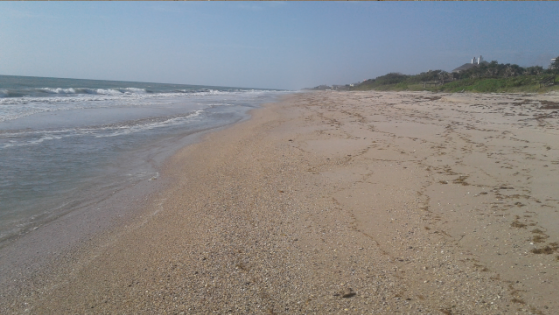Written by the TreasureGuide for the exclusive use of treasurebeachesreport.blogspot.com.
 |
| Turtle Trail Beach Sunday Photo by Darrel S. |
The summer heat is here. Darrel S. sent in these photos. He also sent the brief report that I posted below.
Notice the shells near the water line. The picture below also shows a little dip in front of the beach.
You can find a few shark teeth and other fossils around there at times.
 |
| Another View of Turtle Trail Beach Sunday. Photo by Darrel S. |
Here is Darrel had to say about his hunt.
Better then last few days. More shells, but sand is still thick in low tide line. Very mushy. Nothing but pull tabs and iron debris. Others had similar finds. Mostly clean. Too many detectors in this area for summer!
Thanks for the pictures and report Darrel!
---
Some of you might know Ken H. (Southern Digger). He detailed some of his activities in a recent email to me. Here are some of them.
...I have been enjoying the Gold Shows including Coopers Treasure. It was in 1973 while attending college and visiting Fisher's treasure museum ship in Ft. Lauderdale when being offered a job to dive for Mo in Ft. Pierce to Sebastian area. I did not get certified until 1975 when my dive coach offered me a second opportunity to dive for Mo at Sebastian on the Fisher contracts. However, after I graduated, instead, I personally pursued a wreck at Jupiter Inlet in 1977 but was shut down by the local politics, Soon after,,I was brought into land explorations and archaeology and the work became overwhelming. Therefore, I formed a non-profit society to assist with land archaeology sites in South Florida and one of my members--an X-Marine--after being directed by me, became a diver for Mo in the latter 1980's.Sometime before or thereafter, I am certain that I met Mickos's father at a shipwreck artifact exhibit.,,
...my family took a camping trip to Central Florida East Coast and camped at Sebastian Inlet on the north side and fished at the inlet., Back then, anyone could camp west of the bridge on the north side of the inlet for free. However, no electric or facilities. More important, north of the inlet and east of the bridge was a small cafe and that is where I saw some of Kip Wagner's shipwreck artifacts mounted on the back wall.On inquiring, I was referred to the "Pieces of Eight" book and all things changed after reading it. I called Kip in 1971 or 72-ish asking for wreck locations so that I could detect the beach. I ended up talking to his son and learned that he had recently passed, However, his son spent a good 15-30 minutes and provided me with mileage south of the inlet to each wreck site. After that, I spent trip after trip to the area, searching the beaches between Ft. Pierce and the Sebastian Inlet. Later, I gave these locations to a non-profit historical club member and late-friend after taking him to search the beaches.Later, he converged with a few treasure divers, updated the locations which are now beach parks, and published a book that provides wreck locations which is still popular today. Cooper dived with Kip on occasion and I wished I was born a few years earlier so that I could meet both of them. Never give up the pursuit....
Thanks for sharing Kenneth.
It is interesting how people get into treasure hunting, and there are still a few around who were involved with the early years of detecting.
---
I watched a few metal detecting videos lately and was amazed by the amount of time a lot of people spend on target recovery. Between the first signal and getting the target in the pocket, a lot of time elapses.
One of the advantages of using discrimination that people talk about is saving time by not recovering junk targets. I think sometimes that it is actually not so much a concern about time being wasted as it is about the effort spent in digging and sifting and the frustration that results from seeing a junk target emerge after going through all of that.
I've seen people spend tons of time going over a target multiple times and trying to decipher what the detector is telling them. That spent time does not seem to bother then nearly as much as a little digging. They don't seem to realize how much time they are spending in pinpointing and target ID. I think that is partly, if not entirely because their hopes aren't dashed by seeing a junk target emerge after spending the effort.
I've counted the seconds on some videos and definitely found that many times it would have been quicker to just dig the target and put the junk in one pocket and the goodies in another pocket. Like I said, I'm thinking that the emotion of seeing a junk target emerge magnifies the perception of wasted time.
On the other hand, people aren't disappointed when they mistakenly pass up a good target, even if it is a Rolex watch. They think they did a good thing and go on their way satisfied, never knowing what they missed.
The psychological aspect is an important part of detecting. We talk a lot about the operating characteristics of metal detectors, but the operating characteristics of the detectorist are just as important. How a person detects is very much the result of their personality. To some extent, so is metal detector selection.
If you analyze your style and productivity, you can overcome some your weaknesses. That requires objective analysis, which is more difficult for some people than others.
Happy hunting,
TreasureGuide@comcast.net